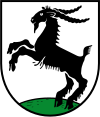Großbockenheim
|
Großbockenheim
Local community Bockenheim an der Weinstrasse
|
||
|---|---|---|
| Coordinates: 49 ° 36 ′ 14 " N , 8 ° 10 ′ 53" E | ||
| Height : | 160 m above sea level NHN | |
| Incorporation : | 1956 | |
| Postal code : | 67278 | |
| Area code : | 06359 | |
|
Location of Großbockenheim in Rhineland-Palatinate |
||
Großbockenheim at the northern end of the German Wine Route in the Palatinate wine-growing region used to be an independent winegrowing village and, together with the second district of Kleinbockenheim, has formed the local community of Bockenheim an der Weinstrasse in the Bad Dürkheim district in Rhineland-Palatinate since 1956 .
location
Großbockenheim extends in a hollow a few hundred meters south of a hill on which Kleinbockenheim is located and which belongs to the Weinstrasse region. With Kleinbockenheim, the place has grown together structurally, so that spatial separation is no longer possible. Großbockenheim also includes Stiegelgasse and most of the Weinstrasse .
history
In 1390 the parish belonged to Simon von Bensheim and Symont Mannesson von Colne ; both owned corresponding Pfandbriefe. In 1538 and 1939, all properties in the village that had belonged to the Hertlingshausen monastery were sold to Count Emich X. and Cuno II of Leiningen. Until the end of the 18th century Großbockenheim belonged to Leiningen-Dagsburg .
From 1798 to 1814, when the Palatinate was part of the French Republic (until 1804) and then part of the Napoleonic Empire , Grosbockenheim - as it was spelled at the time - was incorporated into the canton of Grünstadt and had its own Mairie . In 1815 the place had a total of 600 inhabitants. From 1818 to 1862 "Groß-Bockenheim" was part of the Frankenthal Land Commissioner , which was then converted into a district office.
In 1928 the place had 970 inhabitants who lived in 180 residential buildings. Both Catholics and Protestants owned a local parish at the time. In 1938 the place was incorporated into the Frankenthal district. After the Second World War , Großbockenheim became part of the then newly formed state of Rhineland-Palatinate within the French occupation zone . In 1956, Großbockenheim was merged with the neighboring community of Kleinbockenheim to form the new community of Bockenheim an der Weinstrasse . In the course of the first Rhineland-Palatinate administrative reform, the place moved to the newly created district of Bad Dürkheim . In the period that followed, the gap between Klein- and Großbockenheim became smaller and smaller because the community of Bockenheim and the community of Grünstadt-Land, which existed from 1972 to 2017, established the Emichsburg community center , the fairground and the house of the German Wine Route there.
coat of arms
| Großbockenheim | |
|
Blazon : "In silver on a curved green background a soaring black billy goat."
Coat of arms of the formerly independent municipality |
|
| Foundation of the coat of arms: For the year 1550, a court seal with the seal of the Otterberg Abbey is attested. Since 1719 a community seal, since 1724 a court seal of Großbockenheim is known, which consistently show the billy goat, as it is also proven in 1817. In the 19th century, this coat of arms was in use in Großbockenheim, albeit in a different color. So in 1841 there was no agreement on the color. While the Reichsherold suggested a blue goat, King Ludwig I approved the coat of arms with a black goat on June 27, 1841 according to the drawing presented to him. |
Infrastructure
The German Wine Route runs through the center of the town , and in this area it is identical to Bundesstrasse 271 . There are a total of 17 listed buildings on site, including the Holy Church to the west of the settlement area and surrounded by vineyards . The Bockenheim-Kindenheim station, opened in 1873 on the Palatinate Northern Railway , is located on the north-eastern edge of the town and was designed as a joint station with Kleinbockenheim and the children's home. Passenger traffic was stopped in 1984, but reactivated in 1995.
Personalities
Sons and daughters of the place
- Jakob Kautz (approx. 1500–1532), theologian and reformer
- Anton Straub (1852–1931), Catholic priest, Jesuit, theologian and author
- Arthur Kullmer (1896–1953), infantry general and knight's cross holder
- Karl-Heinz Spieß (* 1948), historian
People who worked on site
- Johann Friedrich Abegg (1718–1789), local pastor from 1767 to 1787
- Karl Ludwig von Leiningen-Dagsburg-Emichsburg allowed services in the Catholic Church
- Caspar II. Lerch acquired land in Großbockenheim
- Joseph Max von Vallade died on the spot
Individual evidence
- ↑ daten.digitale-sammlungen.de: List of localities for the Free State of Bavaria . Retrieved January 20, 2018 .
- ^ Karl Heinz Debus: The great book of arms of the Palatinate. Neustadt an der Weinstrasse 1988, ISBN 3-9801574-2-3 , p. 53.


